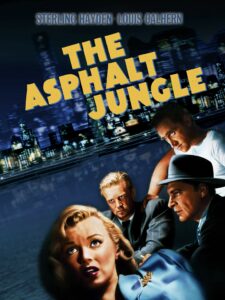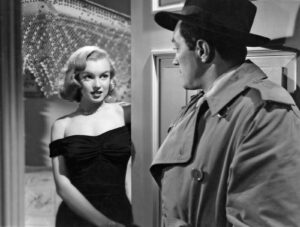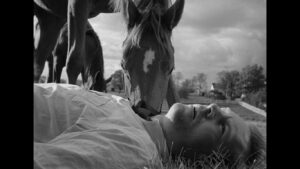“The Asphalt Jungle” – Living in a World Without Rules [Analysis]

Title: “The Asphalt Jungle”
Release Date: 1950
Director: John Huston
Cast: Sterling Hayden, Marilyn Monroe, Louis Calhern, Jean Hagen, James Whitmore, Sam Jaffe, John McIntire
In John Huston’s movie “The Asphalt Jungle”, the title formula becomes a metaphor for the modern world. A man wanders in an urban maze, trying to find a way to realize his dreams. However, accidental fate constantly entangles the paths, and the line between good and evil becomes blurred. And it’s no longer clear whose side is right. “The Asphalt Jungle” is one of the classics of cinema noir, and Marilyn Monroe played one of the first significant roles of her career here.
“The Asphalt Jungle” – the story of a certain theft
“The Asphalt Jungle” is a movie kept in the convention of gangster cinema. Here comes out of prison the legendary Doc Riedenschneider (Sam Jaffe), who has the perfect plan to steal precious stones. He quickly manages to recruit a team of “professionals” and wealthy lawyer Alonzo D. Emmerich (Louis Calhern) to finance the entire operation. At first, everything seems to go smoothly, but several unforeseen circumstances increasingly complicate the whole plan.
Cashier Louis is fatally shot, and fence-sitter Emmerich has no intention of sharing the loot with anyone, as he has become bankrupt by financing the whims of his beautiful young mistress Angela (played by Marilyn Monroe). The brains of the whole operation – the shrewd Doc decides to sneak out of town alone with the jewels, but a chance stop at a cafe is prolonged enough for him to fall into the hands of the police. In turn, bodyguard Dix (Sterling Hayden) with a dangerous gunshot wound thanks to the help of Doll (Jean Hagen), who is in love with him, reaches the family farm, but dies on its doorstep surrounded by his beloved horses. This is the last extremely powerful and symbolic scene of the film.

The city as an “asphalt jungle”
John Huston’s movie is a classic cinema noir, much like the excellent “The Maltese Falcon”, made a few years earlier. Its setting is therefore the city – as a labyrinthine and dynamic space. It is a city portrayed at night, dangerous, full of secrets and nooks and crannies. The darkness of the street is illuminated only by the light of street lamps, so it’s easy to get lost – both literally and metaphorically. The boundaries between good and evil become blurred, and it is no longer clear whether the greater danger is posed by criminals or the police system of oppression. All the more so since guns, a characteristic prop of black cinema, are in the possession of both.
The city as the “asphalt jungle” of the title grows into a metaphor for a world in which traditional moral norms do not apply. Everyone fights for their own by any means available. And while Huston does not depreciate the law, showing that even corrupt police officers ultimately resist crime, the line between order and chaos is clearly shaken.
“The Asphalt Jungle” – “Crime is only a left-handed form of human endeavor”
The most telling sign of this state of affairs is the portraits of the film’s characters. With the exception of a cynical and ruthless fence who intends to rake in all the loot for himself, each character has his own rationale. Louis dreams of securing a good future for his young son, while Dix wants to regain the family farm, which he lost through debt. In this context, the telling words spoken by one of the characters should be understood: “crime is only a left-handed form of human endeavor”.

The criminal path even appears here as a manifestation of “coping in life”, acquiring what cannot be achieved by other methods…This conclusion becomes all the more significant because on the side of order we do not see in Huston’s work crystalline law enforcement officers, but corrupt and even ruthless policemen.
“The Asphalt Jungle” – Huston’s tragic romanticism
However, the movie “The Asphalt Jungle” is not only about the fact that the world is not black and white. The most maturing message of Huston’s film is to show the tragedy of man’s clash with fate. Coincidence, which seems to rule in this reality, makes even the most perfect plan not withstand confrontation with life. It is a series of small, yet significant circumstances that lead the characters to their ultimate defeat. And it is a defeat that is dramatic and at the same time gives the character’s actions romantic qualities.
Dix dying in the bright light of day on his beloved ranch, surrounded by horses is a highly symbolic scene. Only he manages to escape the hell of the “asphalt jungle.” Light and nature are the carriers of the most important values here, but liberation turns out to be unattainable, because it ends in death – at the threshold of the realization of the not at all unattainable dreams.
Literature:
A.Garbicz, J. Klinowski, Kino, wehikuł magiczny. Podróż druga 1950 – 1959, Kraków 1987.
